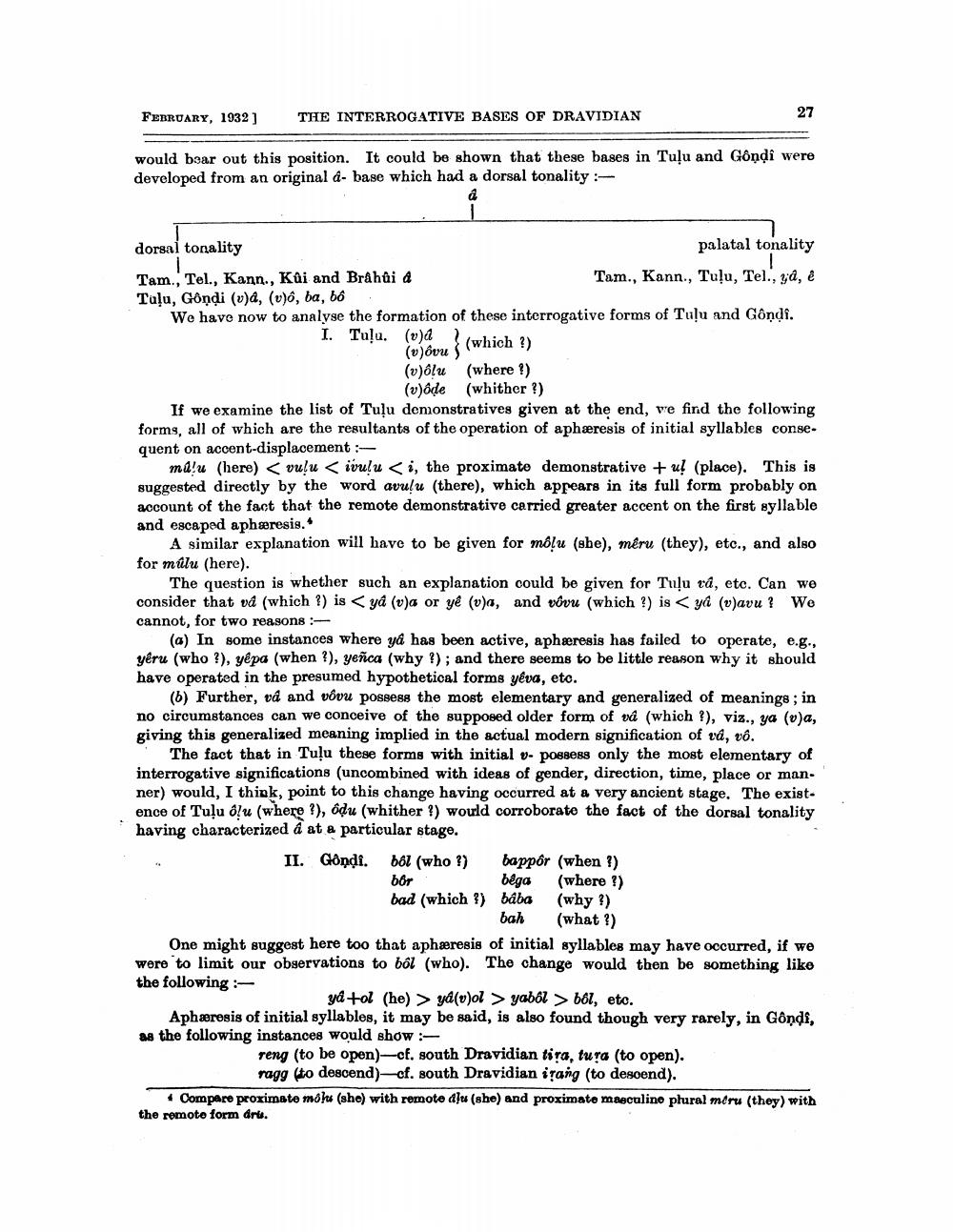________________
FERRUARY, 1932]
THE INTERROGATIVE BASIS OF DRAVIDIAN
27
would boar out this position. It could be shown that these bases in Tulu and Gôndi were developed from an original d- base which had a dorsal tonality :
dorsal tonality
palatal tonality Tam., Tel., Kann., Kui and Bråhai &
Tam., Kann., Tuļu, Tel., ya, e Tuļu, Gôndi (va, (u), ba, bô . We have now to analyse the formation of these interrogative forms of Tuļu and Gôndi. I. Tulu. (v)d
(which ?)
which (v)ôlu (where?)
(v)āde (whither?) If we examine the list of Tuļu demonstratives given at the end, we find the following forms, all of which are the resultants of the operation of aphæresis of initial syllables consequent on accent-displacement -
malu (here) < vulu < ivulu <i, the proximate demonstrative + u! (place). This is suggested directly by the word avulu (there), which appears in its full form probably on account of the fact that the remote demonstrative carried greater accent on the first syllable and escaped aphæresis.
A similar explanation will have to be given for môļu (sbe), mêru (they), etc., and also for múlu (here).
The question is whether such an explanation could be given for Tuļu rá, etc. Can we consider that vd (which ?) is <ya (v)a or ye (va, and vớvu (which ?) is <ya (v)avu? We cannot, for two reasons
(a) In some instances where yd has been active, aphæresis has failed to operate, e.g., yêru (who?), yepa (when ?), yenca (why?); and there seems to be little reason why it should have operated in the presumed hypothetical forms yeva, eto.
(6) Further, va and vôvu possess the most elementary and generalized of meanings; in no circumstances can we conceive of the supposed older form of vá (which ?), viz., ya (v)a, giving this generalized meaning implied in the actual modern signification of vå, vô.
The fact that in Tuļu these forms with initial v- possess only the most elementary of interrogative significations (uncombined with ideas of gender, direction, time, place or manner) would, I think, point to this change having occurred at a very ancient stage. The existence of Tulu olu (where ?), odu (whither ?) would corroborate the fact of the dorsal tonality having characterized å at a particular stage.
II. Gôndi. bøl (who?) bappôr (when ?) bor
bega (where?) bad (which ?) baba (why?)
bah (what?) One might suggest here too that aphæresis of initial syllables may have occurred, if we were to limit our observations to ból (who). The change would then be something like the following
ya tol (he) > ya(u)ol > yaból> 661, etc. Aphæresis of initial syllables, it may be said, is also found though very rarely, in Gôndi, as the following instances would show :
reng (to be open)-of, south Dravidian tira, tura (to open).
ragg (to descend)-cf. south Dravidian isang (to desoend). Compare proximate mol (she) with remote alu (she) and proximate masculine plural méru (they) with the remote form art.




